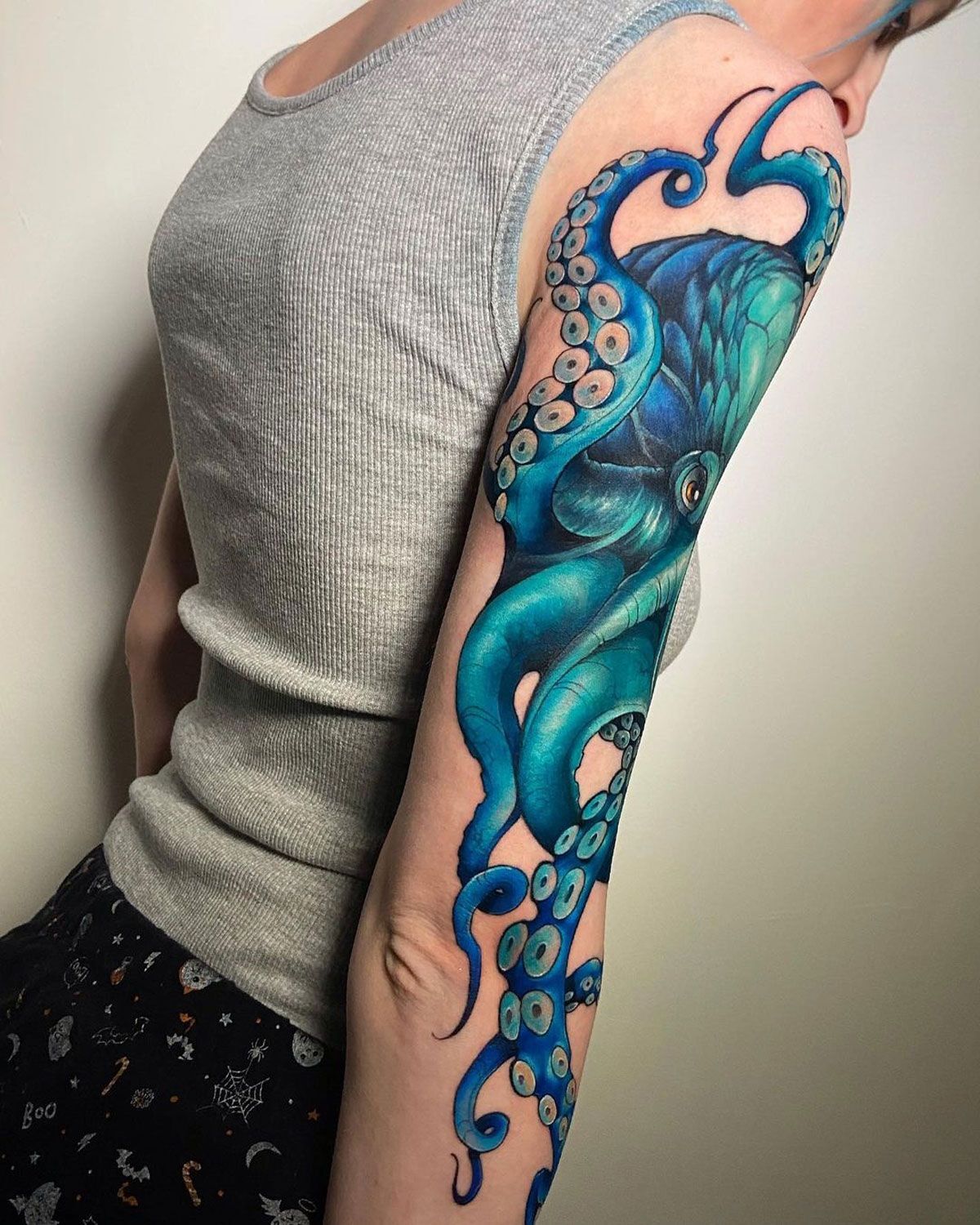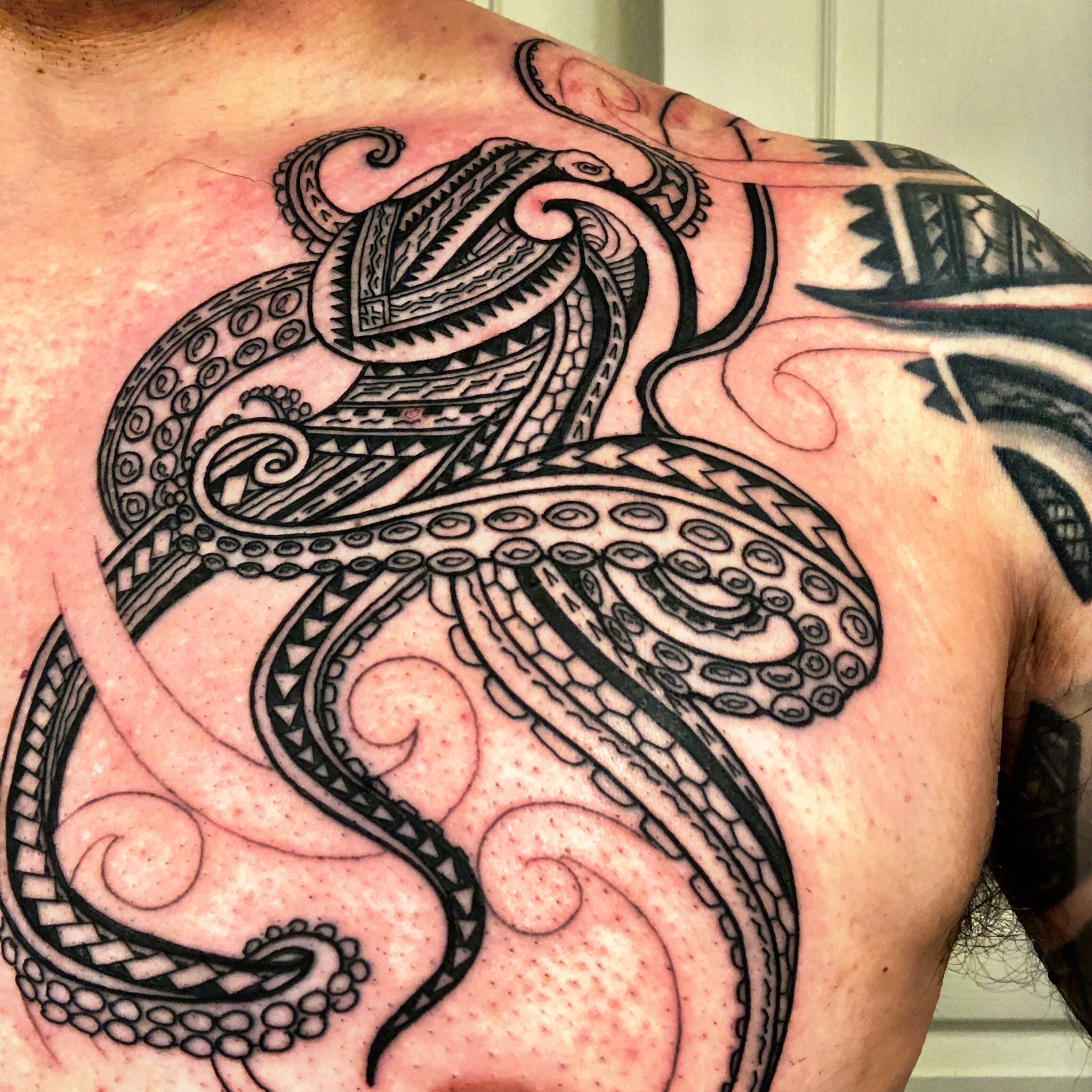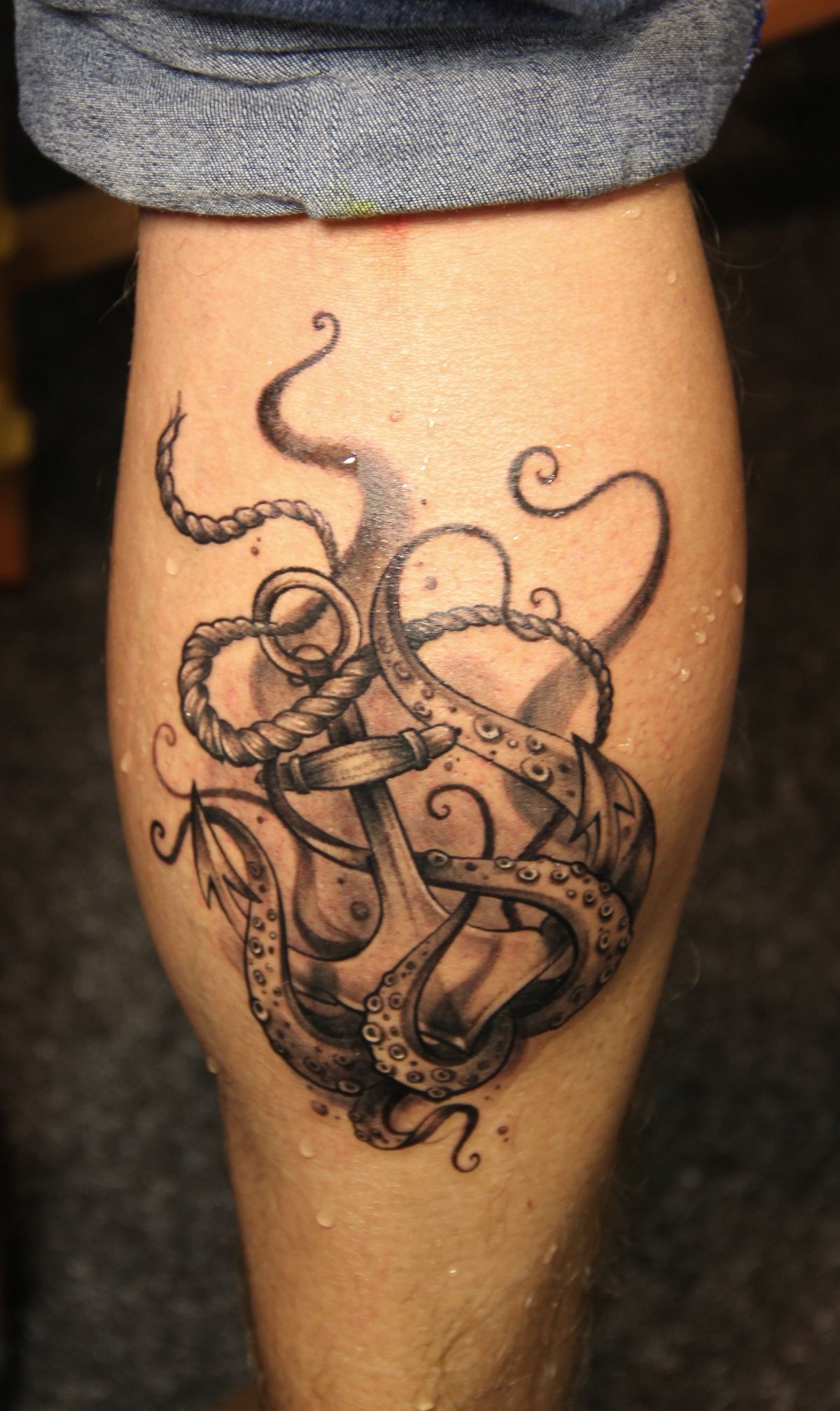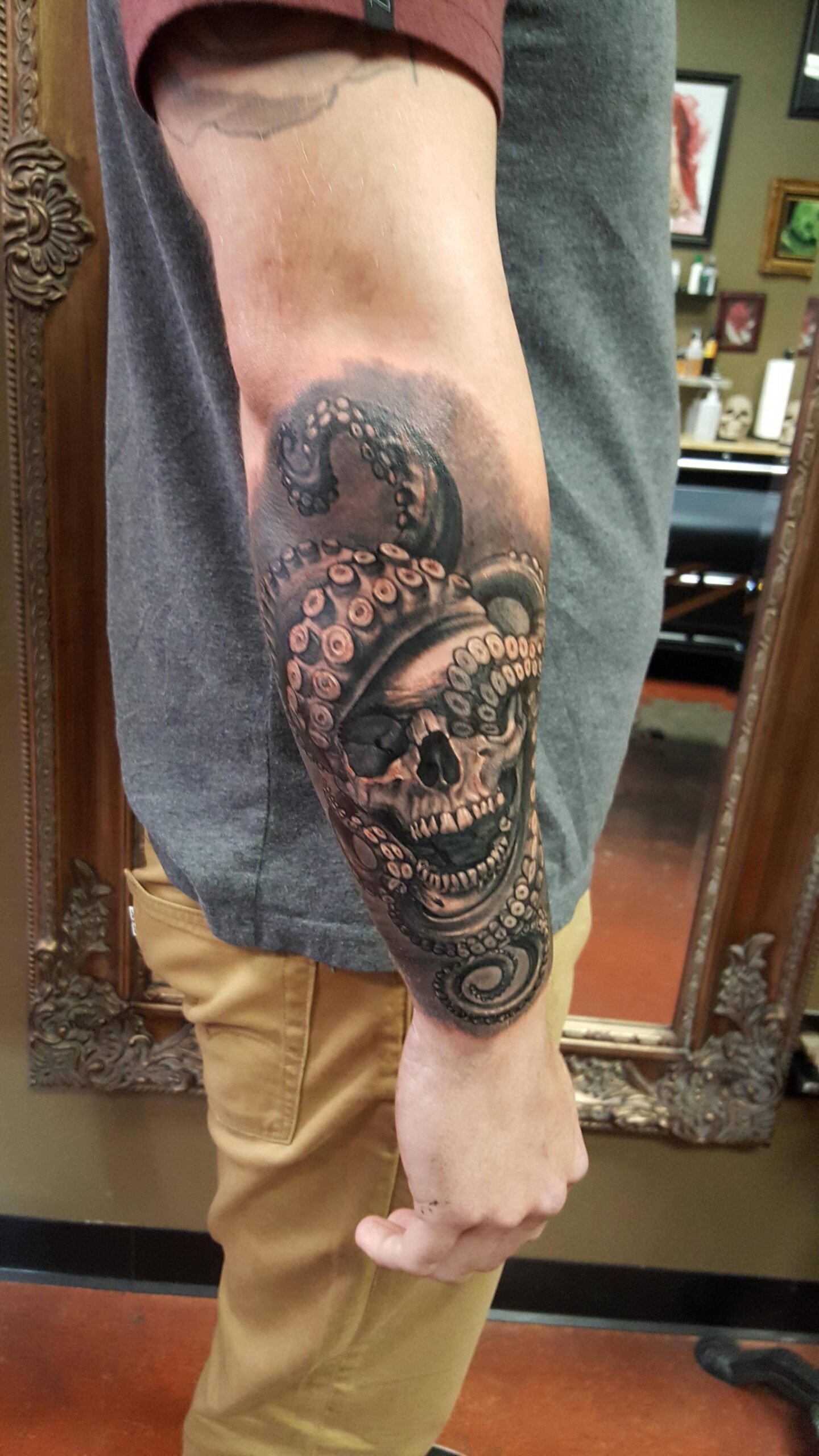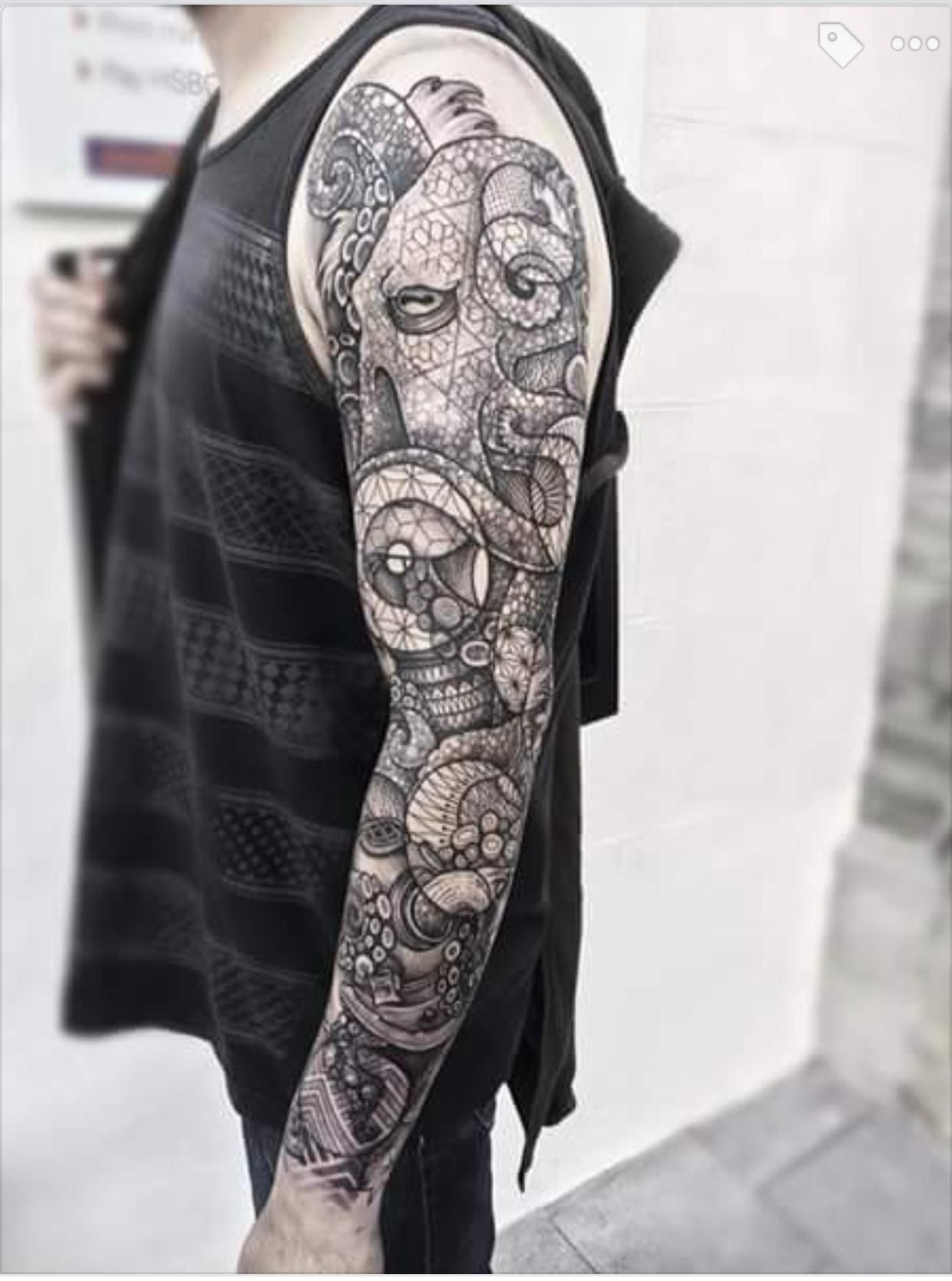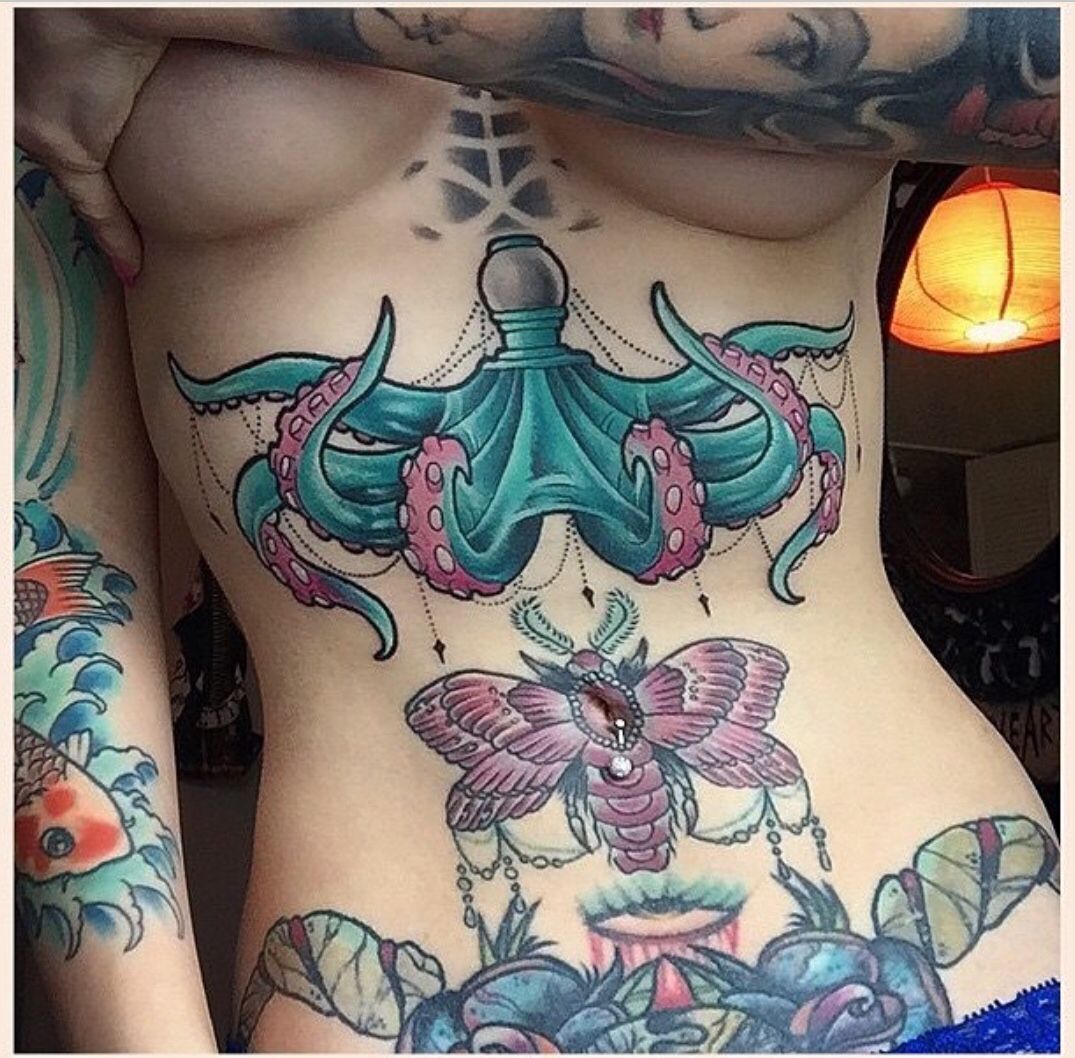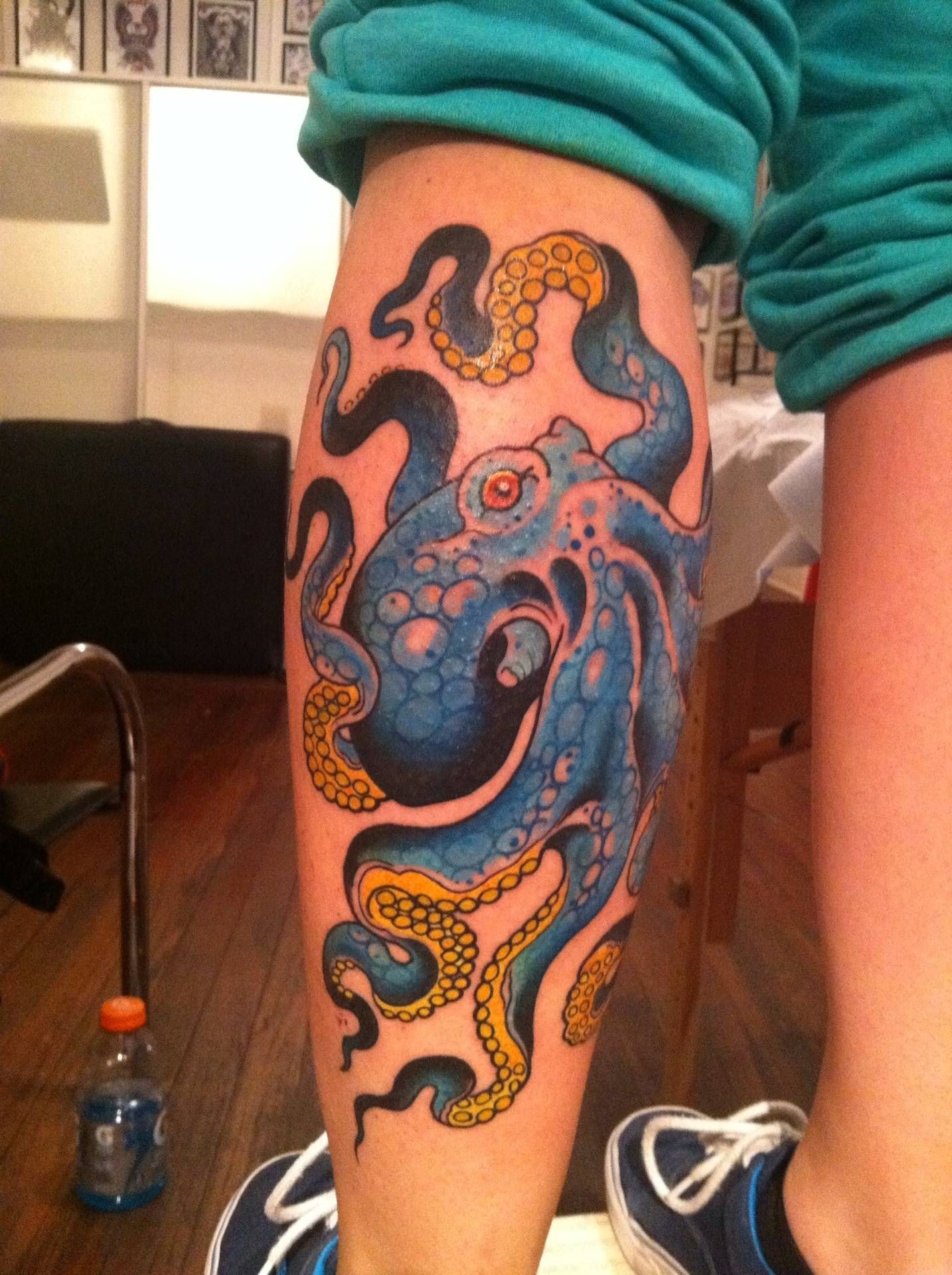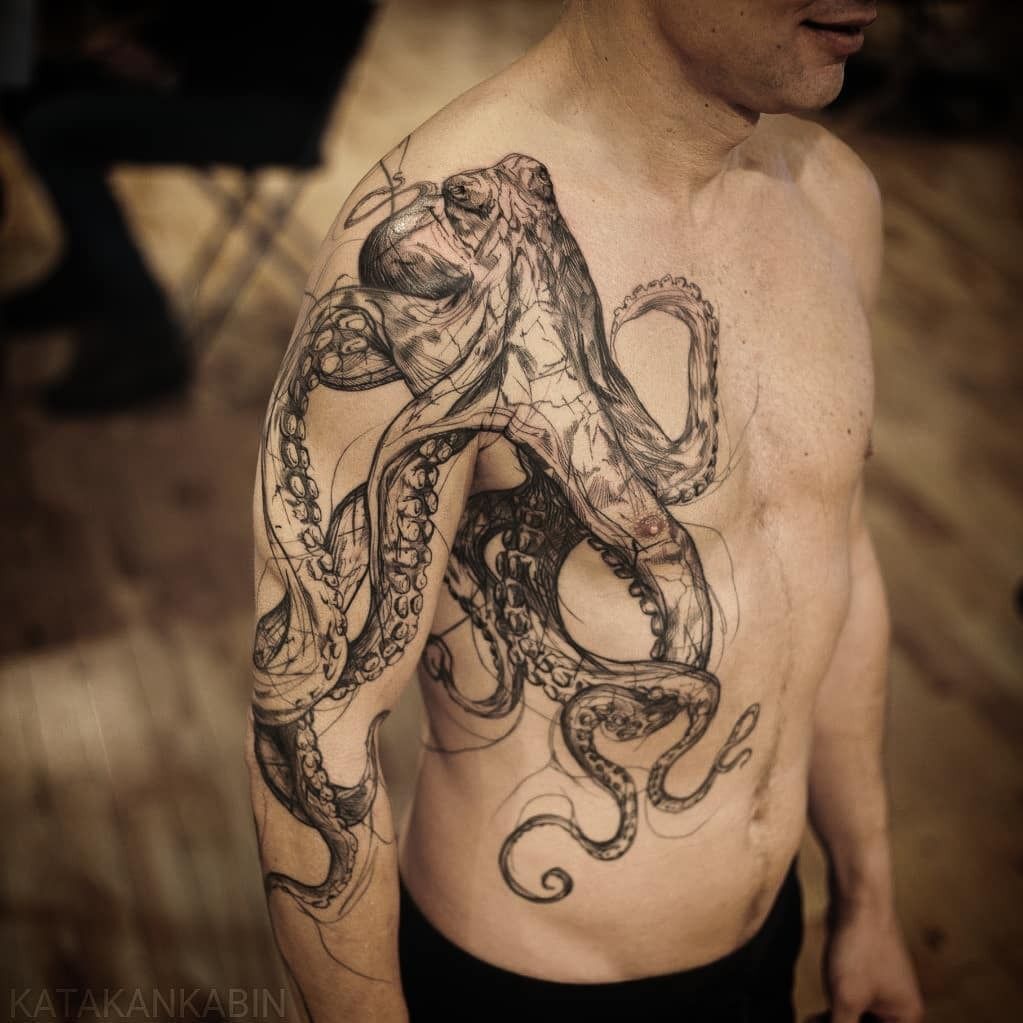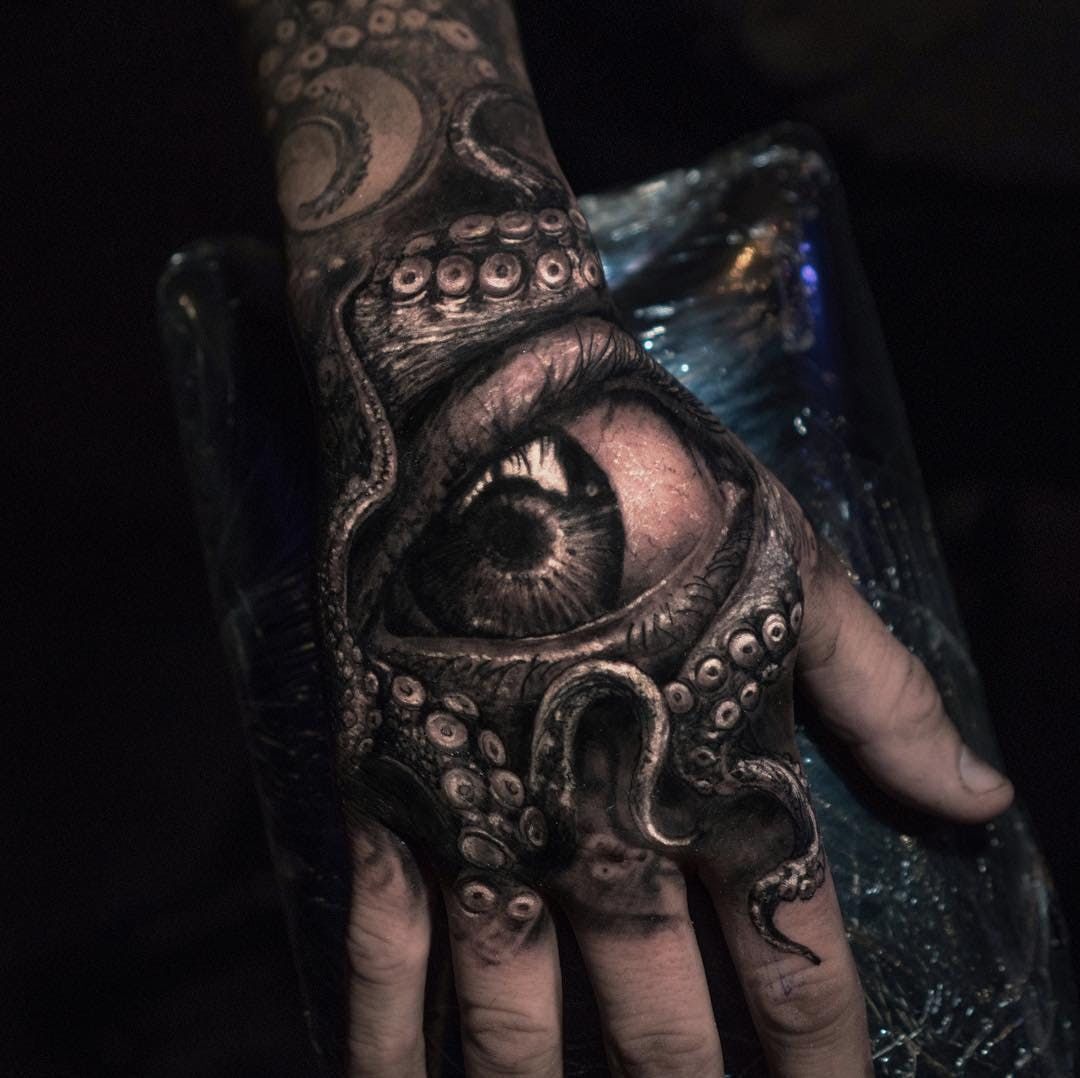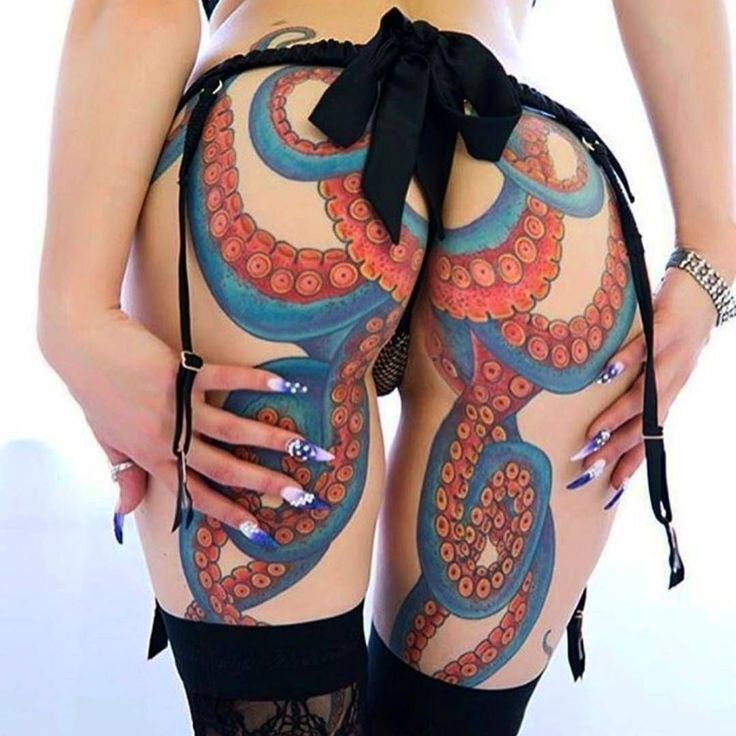Thanks to their intricate designs and deep symbolic meanings, Octopus tattoos are popular among tattoo enthusiasts. These mysterious sea creatures have been revered in many cultures for centuries, and their symbolism has been passed down through the ages. This article will explore everything you need about octopus tattoos, including their symbolism, meanings, and top-rated designs.
Are you only interested in tattoo designs and want to skip the educational part?
No problem, we got you covered! Click HERE to get inspired.
What does the octopus symbolize?
In various cultures and literature, the octopus symbolizes complexity, diversity, mystery, intelligence, adaptability, and unpredictability. It's renowned for its remarkable intellect and problem-solving skills, mirroring an intricate and analytical mind. The octopus's ability to change color and texture serves as a powerful symbol of adaptability and flexibility, inspiring us to adjust to new circumstances with grace and resilience.
Moreover, its camouflage abilities also speak to the themes of illusion and deception. The creature's eight tentacles, each having a mind of its own, add to the symbolism of diversity and versatility, and sometimes also represent the spreading of knowledge in multiple directions.
As a creature of the sea, it holds deep and mysterious aspects, often being associated with the unknown depths of the ocean and the subconscious mind.
What is the meaning behind octopus tattoos?
Octopus tattoos embody a wide array of meanings due to the creature's rich symbolic significance. They often represent adaptability, intelligence, mystery, and complexity. When someone gets an octopus tattoo, they might be showcasing their adaptability and flexibility in life, resonating with the octopus's ability to change color and form in response to its surroundings.
The creature's renowned intellect and problem-solving skills can symbolize a person's analytical mind or their knack for overcoming obstacles. The octopus's mysterious nature and its dwelling in the deep sea connect it with the unknown, the subconscious, or deep emotions, hence an octopus tattoo could signify a person's exploration of these realms.
Furthermore, the multiplicity of the octopus's limbs can denote diversity, expansion, and the reaching out in various directions, possibly marking personal growth or the pursuit of knowledge.
It's important to note that the specific meaning of an octopus tattoo can vary greatly depending on the individual's personal interpretation and the context in which the symbol is used.
best octopus tattoo ideas and their meanings
Revered for their intelligence, adaptability, and mysterious nature, octopuses have made a significant mark in the realm of body art. In this compilation, we dive deep into the top-rated octopus tattoo designs, unraveling their unique aesthetics and the rich meanings they hold.
Realistic Octopus Tattoo
This design aims to capture the lifelike features of an octopus, showcasing its complex anatomy and unique texture. It signifies a deep respect for nature's intricacies, intelligence, and adaptability, embodying the wearer's acknowledgement of these traits in their own life.
Tribal Octopus Tattoo
These are stylized using traditional tribal patterns. While symbolizing the typical octopus themes of adaptability and intellect, tribal versions often have cultural meanings tied to specific indigenous groups. For instance, in Polynesian culture, it might signify protection or the defeat of enemies.
Octopus and Anchor Tattoo
An octopus entwined around an anchor combines the symbolism of both elements. The octopus represents adaptability and intelligence, while the anchor stands for stability, strength, and persistence. Together, they can symbolize a harmonious balance between flexibility and stability in life.
Skull and Octopus Tattoo
The combination of a skull, often associated with mortality or the cycle of life and death, and an octopus can represent a deep exploration of life's mysteries, the subconscious, and the unknown. It might also signify resilience, marking the wearer's ability to navigate through life's transformative phases.
Geometric Octopus Tattoo
This design, typically abstract and modern, uses geometric shapes to depict the octopus. It merges the octopus's symbolism of flexibility and intellect with the geometric themes of structure, balance, and unity. This can represent the wearer's attempt to find balance between fluidity and structure in their life.
Best octopus tattoo placement ideas and their meanings
Tattoo placements can be as personal and symbolic as the designs themselves. The location of your octopus tattoo can enhance its meaning, reflecting aspects of your personality, aesthetic preferences, and even the narrative you wish to tell. An octopus tattoo, known for its adaptability, lends itself to a variety of placements due to its flexible form and symbolic versatility. Here, we explore a few prominent placements for an octopus tattoo and the potential meanings they hold:
Octopus Sternum Tattoo
The sternum, or the center of the chest, is a highly personal area, often chosen for designs that hold deep personal significance. An octopus sternum tattoo could signify a person's core intelligence or their heart's adaptability, echoing the creature's attributes. It's an intimate location, reflecting personal growth and emotional depth.
Octopus Calf Tattoo
Tattoos on the calf often represent strength and forward movement, as legs are associated with progress and journey. An octopus on the calf can symbolize a person's adaptability and resilience on their life's path. It denotes moving forward with versatility and intelligence, regardless of life's challenges.
Octopus Shoulder Tattoo
Shoulder tattoos often stand for carrying responsibility, strength, and power. An octopus here might signify the bearer's capacity to juggle multiple roles and tasks effectively, akin to the octopus's multi-limbed agility. It could also represent a shoulder's flexibility, reflecting the adaptable nature of the octopus.
Octopus Hand Tattoo
Tattoos on the hand are highly visible and often indicate something the wearer is unafraid to express openly. An octopus hand tattoo could signify a person's open embrace of their complexity, adaptability, or their reach into diverse areas of knowledge and experience. It's a bold statement of accepting and showcasing one's multifaceted nature.
Octopus Ass Tattoo
The lower back is often chosen for its sensual appeal and its connection to primal energy in some cultures. An octopus tattoo in this area could symbolize one's deep-seated adaptability and the mysterious allure associated with the creature. It could also reflect a connection to the depths of one's subconscious mind, echoing the octopus's habitat in the deep sea.
Who should get an octopus tattoo?
An octopus tattoo is a great choice for anyone who feels a deep connection with the sea and its mysterious creatures. Particularly, if you're someone who resonates with the attributes commonly associated with the octopus - such as intelligence, adaptability, complexity, and a sense of exploration - this might be the perfect design for you.
It could also be an excellent choice for those who value versatility and flexibility, mirroring the octopus's ability to change its shape and color in response to its environment. If you see yourself as a problem-solver or a highly creative individual, an octopus tattoo could symbolize these traits.
Furthermore, as octopuses are known for their multiple limbs operating semi-independently, individuals who juggle multiple tasks or roles might find this symbolism fitting. The octopus can represent their ability to spread their energy and attention across diverse areas effectively.
Lastly, an octopus tattoo might appeal to those drawn to the enigmatic. The octopus inhabits the depths of the ocean, a realm full of mystery and unexplored territories, making it a suitable symbol for people who are intrigued by the unknown or are on a journey of self-discovery.
As with any tattoo, personal resonance with the symbol is key. The best person to get an octopus tattoo is someone who feels a personal connection to the various symbolic meanings attributed to this fascinating sea creature.
General Breakdown Of Tattoo Pain Levels On Different Body Parts
Here is a breakdown of the different tattoo pain levels:
- Low: This level of pain is generally described as a mild discomfort or tickling sensation. It is similar to the sensation of getting a light scratch or scrape.
- Moderate: This level of pain is generally described as a moderate discomfort or aching sensation. It is similar to the sensation of getting a deep scratch or scrape or being pinched.
- High: This level of pain is generally described as a strong discomfort or throbbing sensation. It is similar to the sensation of getting a burn or being stung by a bee.
It's important to note that pain tolerance is highly individual and can vary greatly from person to person. Some people may find certain body parts more or less painful than others, and the same body part can be more or less painful for different people. Additionally, the level of pain can be affected by factors such as the size and location of the tattoo, the skill of the tattoo artist, and the individual's own pain threshold.
Tattoo placement pain level chart
Body Part | Pain Level | Explanation |
Forehead | Low | The forehead has few nerve endings, so it is not a particularly painful area. |
Eyebrows | Low | The eyebrows have few nerve endings, so the pain level is relatively low. |
Ear | Low | The ear is a relatively thin and fleshy area, so the pain level is low. |
Nostril | Low | The nostril is a small area with thin skin, so the pain level is low. |
Lip | Low to Moderate | The lip has more nerve endings than some other areas, so it may be slightly more painful. |
Cheek | Low to Moderate | The cheek has a moderate amount of nerve endings, so it may be slightly more painful. |
Moderate | The neck has a moderate amount of nerve endings, so it may be slightly more painful. | |
Moderate to High | The chest has a high concentration of nerve endings, so it can be quite painful. | |
Abdomen | High | The abdomen has a high concentration of nerve endings, so it can be quite painful. |
Back | High | The back has a high concentration of nerve endings, so it can be quite painful. |
Shoulders | High | The shoulders have a high concentration of nerve endings, so they can be quite painful. |
Upper Arms | Moderate to High | The upper arms have a moderate to high concentration of nerve endings, so they can be somewhat painful. |
Elbows | High | The elbows have a high concentration of nerve endings, so they can be quite painful. |
Forearms | Moderate | The forearms have a moderate concentration of nerve endings, so they are not as painful as some other areas. |
Hands | High | The hands have a high concentration of nerve endings, so they can be quite painful. |
Lower Arms | Low to Moderate | The lower arms have a lower concentration of nerve endings, so they are not as painful as some other areas. |
Wrists | Low | The wrists have a low concentration of nerve endings, so they are not very painful. |
Lower Back | High | The lower back has a high concentration of nerve endings, so it can be quite painful. |
Buttocks | High | The buttocks have a high concentration of nerve endings, so they can be quite painful. |
Thighs | High | The thighs have a high concentration of nerve endings, so they can be quite painful. |
Knees | High | The knees have a high concentration of nerve endings, so they can be quite painful. |
Calves | Low to Moderate | The calves have a low to moderate concentration of nerve endings, so they are not as painful as some other areas. |
Ankles | Low | The ankles have a low concentration of nerve endings, so they are not very painful. |
Tattoo aftercare tips
Before getting a tattoo:
Choose a reputable tattoo artist and parlor. Research the artist's portfolio and read reviews from previous clients.
Consult with the artist about the design and placement of the tattoo.
Make sure you are in good health. If you have any medical conditions or are taking any medications that may affect your ability to heal, be sure to let your tattoo artist know.
Consider using a numbing cream to reduce pain during the tattooing process. These creams contain a numbing agent (such as lidocaine) that can be applied to the skin before the tattoo is done. It's important to follow the instructions on the numbing cream and to only use it as directed.
Avoid alcohol, caffeine, and other substances that can thin your blood for at least 24 hours before getting a tattoo.
Eat a healthy meal before your tattoo session to ensure that your blood sugar is stable.
Wear loose, comfortable clothing that allows easy access to the area being tattooed.
After getting a tattoo:
Follow the aftercare instructions provided by your tattoo artist. These may include:
Keeping the tattoo clean and covered with a bandage for the first few hours after getting tattooed.
Washing the tattoo with lukewarm water and a mild soap (such as unscented, antimicrobial soap) and patting it dry with a clean towel.
Applying a thin layer of tattoo ointment or lotion (such as A&D or Aquaphor) to the tattoo and covering it with a clean bandage or wrap.
Repeating this process for the first few days, or until the tattoo has fully scabbed over.
Avoid soaking the tattoo in water for the first week, such as in a bath or pool.
Avoid picking or scratching at the scabs, as this can cause the tattoo to fade or become infected.
Avoid exposure to direct sunlight or tanning beds for at least 2-4 weeks.
If you experience any redness, swelling, or unusual discharge, contact your tattoo artist or a healthcare professional.
Overall, it's important to keep your tattoo clean and moisturized during the healing process to ensure that it heals properly and looks its best. Using a numbing cream can help reduce pain during the tattooing process, but it's important to use it as directed and to follow all aftercare instructions to ensure that your tattoo heals properly.
People Also Ask:
What does an octopus tattoo symbolize?
An octopus tattoo typically symbolizes intelligence, adaptability, complexity, and mystery. It can also represent versatility and exploration of the unknown or subconscious. However, the specific symbolism can vary greatly depending on individual interpretation and context.
Is an octopus tattoo a good choice for me?
An octopus tattoo could be an excellent choice if you resonate with its symbolic meanings such as intelligence, adaptability, and exploration. It could also be ideal if you feel a connection to the sea and its creatures, or if you appreciate the visual complexity and beauty of the octopus.
Are there different styles of octopus tattoos?
Yes, there are various styles of octopus tattoos. These include realistic, tribal, illustrative, geometric, and many more. The style you choose can reflect your personal aesthetic and what you want the tattoo to symbolize.
What do different styles of octopus tattoos mean?
Each style can have its unique meanings. For example, a realistic octopus tattoo can symbolize respect for nature and its complexity, while a tribal design might represent cultural ties or protection. The meaning of a geometric octopus tattoo could be finding a balance between structure and flexibility.
Where is the best place on the body to get an octopus tattoo?
The location for an octopus tattoo largely depends on your personal preference and the size of the design. Octopus tattoos can be very flexible, suiting various body parts like the arm, leg, back, or even chest. Small octopus tattoos can look great on the wrist, ankle, or behind the ear.
Are octopus tattoos popular?
Yes, octopus tattoos have gained popularity due to their rich symbolism and unique visual appeal. They offer a lot of room for artistic creativity and can be customized in numerous ways to reflect the wearer's personal style and story.
What colors work well for an octopus tattoo?
Octopus tattoos can look stunning in both color and black and grey. The choice of color will depend on your personal preference and the design's style. Vibrant colors can mimic the variety of hues an octopus can turn into, while black and grey can bring out the creature's texture and details.
What cultural significance does an octopus tattoo have?
In various cultures, an octopus carries different symbolic meanings. For instance, in Polynesian culture, it is often associated with protection and defeating enemies. In Japanese folklore, the octopus is seen as a powerful and intelligent creature.
Do octopus tattoos have any negative connotations?
While the octopus is generally viewed positively for its intelligence and adaptability, some interpretations connect it with illusion and deception due to its camouflage abilities. However, tattoos are highly personal, and their meaning often depends more on the wearer's interpretation than any universally agreed symbolism.
How long does an octopus tattoo take to complete?
The duration depends on the size, complexity, and detail of the design, as well as the artist's speed. A small, simple octopus tattoo might take a couple of hours, while a large, detailed piece can require multiple sessions. It's best to consult with your tattoo artist for an accurate estimate.
Watch A video of a octopus tattoo done by a pro
165+ octopus tattoo Ideas to get inspired from
Final thoughts
Thanks to their intricate designs and deep symbolic meanings, Octopus tattoos are popular among tattoo enthusiasts. They symbolize intelligence, adaptability, and mystery, making them an excellent option for those who feel a connection to the ocean or the symbolism of the octopus. Whether you're looking for a traditional design or a more modern take on the octopus, there are plenty of options.

